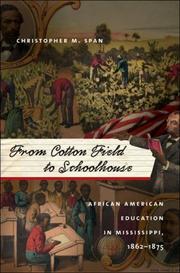| Listing 1 - 10 of 21 | << page >> |
Sort by
|
Book
ISBN: 081472387X 9780814723876 9780814708415 0814708412 Year: 2013 Publisher: New York, NY
Abstract | Keywords | Export | Availability | Bookmark
 Loading...
Loading...Choose an application
- Reference Manager
- EndNote
- RefWorks (Direct export to RefWorks)
Winner of the 2013 Frank S. and Elizabeth D. Brewer Prize presented by the American Society of Church History Mississippi Praying examines the faith communities at ground-zero of the racial revolution that rocked America. This religious history of white Mississippians in the civil rights era shows how Mississippians’ intense religious commitments played critical, rather than incidental, roles in their response to the movement for black equality. During the civil rights movement and since, it has perplexed many Americans that unabashedly Christian Mississippi could also unapologetically oppress its black population. Yet, as Carolyn Renée Dupont richly details, white southerners’ evangelical religion gave them no conceptual tools for understanding segregation as a moral evil, and many believed that God had ordained the racial hierarchy. Challenging previous scholarship that depicts southern religious support for segregation as weak, Dupont shows how people of faith in Mississippi rejected the religious argument for black equality and actively supported the effort to thwart the civil rights movement. At the same time, faith motivated a small number of white Mississippians to challenge the methods and tactics of do-or-die segregationists. Racial turmoil profoundly destabilized Mississippi’s religious communities and turned them into battlegrounds over the issue of black equality. Though Mississippi’s evangelicals lost the battle to preserve segregation, they won important struggles to preserve the theology that had sustained the racial hierarchy. Ultimately, this history sheds light on the eventual rise of the religious right by elaborating the connections between the pre- and post-civil rights South.
Civil rights movements --- Evangelicalism --- Evangelical religion --- Protestantism, Evangelical --- Evangelical Revival --- Fundamentalism --- Pietism --- Protestantism --- History --- Mississippi --- State of Mississippi --- Missisipi --- Місісіпі --- Misisipi --- Штат Місісіпі --- Shtat Misisipi --- Мисисипи --- Щат Мисисипи --- Mísísípii Hahoodzo --- Mississippi osariik --- Μισισιπι --- Πολιτεία του Μισισίπι --- Politeia tou Misisipi --- Estado de Misisipi --- Misisipio --- État du Mississippi --- Mississippy --- 미시시피 주 --- Misisipʻi-ju --- 미시시피 --- Mikikipi --- מיסיסיפי --- מדינת מיסיסיפי --- Medinat Misisipi --- US-MS --- MS (State : Mississippi) --- MI (State : Mississippi) --- Miss. --- Church history

ISBN: 0817381325 9780817381325 0817315195 9780817315191 Year: 2006 Publisher: Tuscaloosa University of Alabama Press
Abstract | Keywords | Export | Availability | Bookmark
 Loading...
Loading...Choose an application
- Reference Manager
- EndNote
- RefWorks (Direct export to RefWorks)
The rehearsal for the March to the Sea. With the fall of Vicksburg to Union forces in mid-1863, the Federals began work to extend and consolidate their hold on the lower Mississippi Valley. As a part of this plan, Major General William Tecumseh Sherman set out from Vicksburg on February 3, 1864, with an army of some 25,000 infantry and a battalion of cavalry. They expected to be joined by another Union force moving south from Memphis and supported themselves off the land as they traveled due east across Mississippi. She
Strategy --- Military strategy --- Military art and science --- Military doctrine --- Sherman, William T. --- Sherman, W. T. --- Sherman, William Tecumseh, --- Sherman, Wm. T. --- Military leadership. --- United States --- Meridian (Miss.) --- Mississippi --- State of Mississippi --- Missisipi --- Місісіпі --- Misisipi --- Штат Місісіпі --- Shtat Misisipi --- Мисисипи --- Щат Мисисипи --- Mísísípii Hahoodzo --- Mississippi osariik --- Μισισιπι --- Πολιτεία του Μισισίπι --- Politeia tou Misisipi --- Estado de Misisipi --- Misisipio --- État du Mississippi --- Mississippy --- 미시시피 주 --- Misisipʻi-ju --- 미시시피 --- Mikikipi --- מיסיסיפי --- מדינת מיסיסיפי --- Medinat Misisipi --- US-MS --- MS (State : Mississippi) --- MI (State : Mississippi) --- Miss. --- Meridian, Miss. --- History --- Campaigns. --- History, Military

ISBN: 0191605050 0191560502 0585363447 9780191560507 9780585363448 9780191605055 0192824414 9780192824417 9780199536559 0199536554 0191920703 Year: 1999 Publisher: Oxford New York Oxford University Press
Abstract | Keywords | Export | Availability | Bookmark
 Loading...
Loading...Choose an application
- Reference Manager
- EndNote
- RefWorks (Direct export to RefWorks)
The story of Huck's escape from his brutal father and the relationship that grows between him and Jim, a slave fleeing an even more brutal oppression, proved enormously influential in the development of American literature.
Finn, Huckleberry (Fictitious character) --- Runaway children --- Male friendship --- Fugitive slaves --- Race relations --- Boys --- Mississippi River --- Missouri --- Finn, Huckleberry --- Finn, Huck --- Twain, Mark, --- Mississippi --- State of Mississippi --- Missisipi --- Місісіпі --- Misisipi --- Штат Місісіпі --- Shtat Misisipi --- Мисисипи --- Щат Мисисипи --- Mísísípii Hahoodzo --- Mississippi osariik --- Μισισιπι --- Πολιτεία του Μισισίπι --- Politeia tou Misisipi --- Estado de Misisipi --- Misisipio --- État du Mississippi --- Mississippy --- 미시시피 주 --- Misisipʻi-ju --- 미시시피 --- Mikikipi --- מיסיסיפי --- מדינת מיסיסיפי --- Medinat Misisipi --- US-MS --- MS (State : Mississippi) --- MI (State : Mississippi) --- Miss. --- Social life and customs
Book
ISBN: 0815651066 9780815651062 9780815609384 0815609388 Year: 2009 Publisher: Syruacuse, N.Y. : Syracuse University Press,
Abstract | Keywords | Export | Availability | Bookmark
 Loading...
Loading...Choose an application
- Reference Manager
- EndNote
- RefWorks (Direct export to RefWorks)
In We Had Sneakers, They Had Guns, Sugarman chronicles the sacrifices, tragedies, and triumphs of that unprecedented moment in our nation's history. Two white students and one black student were slain in the struggle, many were beaten and hundreds arrested, and churches and homes were burned to the ground by the opponents of equality. Yet the example of Freedom Summer- whites united with heroic black Mississippians to challenge apartheid-resonated across the nation. The United States Congress was finally moved to pass the civil rights legislation that enfranchised the millions of black Americans who had been waiting for equal rights for a century. Blending oral history with memoir, this draws the reader into the lives of Sugarman's subjects, showing the passion and naivete of the volunteers, the bravery of the civil rights leaders, and the candid, sometimes troubling reactions of the black and white Delta residents. Sugarman's unique reportorial art, in word and image, makes this book a vital record of our nation's past.
African Americans --- Civil rights workers --- Civil rights movements --- Afro-Americans --- Black Americans --- Colored people (United States) --- Negroes --- Africans --- Ethnology --- Blacks --- Civil rights activists --- Race relations reformers --- Social reformers --- Civil rights --- History --- Sugarman, Tracy, --- Mississippi --- State of Mississippi --- Missisipi --- Місісіпі --- Misisipi --- Штат Місісіпі --- Shtat Misisipi --- Мисисипи --- Щат Мисисипи --- Mísísípii Hahoodzo --- Mississippi osariik --- Μισισιπι --- Πολιτεία του Μισισίπι --- Politeia tou Misisipi --- Estado de Misisipi --- Misisipio --- État du Mississippi --- Mississippy --- 미시시피 주 --- Misisipʻi-ju --- 미시시피 --- Mikikipi --- מיסיסיפי --- מדינת מיסיסיפי --- Medinat Misisipi --- US-MS --- MS (State : Mississippi) --- MI (State : Mississippi) --- Miss. --- Race relations --- 20th century --- Biography --- Sugarman, Tracy --- Black people
Book
ISBN: 1469631172 1469631164 9781469631165 9781469631172 9781469631158 1469631156 1469654806 9798890851918 Year: 2017 Publisher: Chapel Hill
Abstract | Keywords | Export | Availability | Bookmark
 Loading...
Loading...Choose an application
- Reference Manager
- EndNote
- RefWorks (Direct export to RefWorks)
Just as Mississippi whites in the 1950s and 1960s had fought to maintain school segregation, they battled in the 1970s to control the school curriculum. In 1974, when Pantheon Books published 'Mississippi: Conflict and Change', the defenders of traditional interpretation struck back at the innovative textbook. Charles W. Eagles explores the story of the controversial ninth-grade history textbook and the court case that allowed its adoption with state funds.
Civil rights --- History --- Basic rights --- Civil liberties --- Constitutional rights --- Fundamental rights --- Rights, Civil --- Constitutional law --- Human rights --- Political persecution --- Annals --- Auxiliary sciences of history --- History. --- Study and teaching (Secondary) --- Law and legislation --- Mississippi --- State of Mississippi --- Missisipi --- Місісіпі --- Misisipi --- Штат Місісіпі --- Shtat Misisipi --- Мисисипи --- Щат Мисисипи --- Mísísípii Hahoodzo --- Mississippi osariik --- Μισισιπι --- Πολιτεία του Μισισίπι --- Politeia tou Misisipi --- Estado de Misisipi --- Misisipio --- État du Mississippi --- Mississippy --- 미시시피 주 --- Misisipʻi-ju --- 미시시피 --- Mikikipi --- מיסיסיפי --- מדינת מיסיסיפי --- Medinat Misisipi --- US-MS --- MS (State : Mississippi) --- MI (State : Mississippi) --- Miss. --- Textbooks.
Book
ISBN: 9781469623115 1469623110 1469620936 9781469620930 1469620944 9781469620947 9781469620930 9781469620947 9798890843975 9798890843968 Year: 2015 Publisher: Chapel Hill
Abstract | Keywords | Export | Availability | Bookmark
 Loading...
Loading...Choose an application
- Reference Manager
- EndNote
- RefWorks (Direct export to RefWorks)
The South's system of Jim Crow racial oppression is usually understood in terms of legal segregation that mandated the separation of white and black Americans. Yet, as this work shows, it was also a high-stakes drama that played out in the routines of everyday life, where blacks and whites regularly interacted on sidewalks and buses and in businesses and homes. Every day, individuals made, unmade, and remade Jim Crow in how they played their racial roles-how they moved, talked, even gestured. The highly visible but often subtle nature of these interactions constituted the Jim Crow routine.
African Americans --- Racism --- Afro-Americans --- Black Americans --- Colored people (United States) --- Negroes --- Africans --- Ethnology --- Blacks --- Bias, Racial --- Race bias --- Race prejudice --- Racial bias --- Prejudices --- Anti-racism --- Critical race theory --- Race relations --- Social life and customs --- History --- Mississippi --- State of Mississippi --- Missisipi --- Місісіпі --- Misisipi --- Штат Місісіпі --- Shtat Misisipi --- Мисисипи --- Щат Мисисипи --- Mísísípii Hahoodzo --- Mississippi osariik --- Μισισιπι --- Πολιτεία του Μισισίπι --- Politeia tou Misisipi --- Estado de Misisipi --- Misisipio --- État du Mississippi --- Mississippy --- 미시시피 주 --- Misisipʻi-ju --- 미시시피 --- Mikikipi --- מיסיסיפי --- מדינת מיסיסיפי --- Medinat Misisipi --- US-MS --- MS (State : Mississippi) --- MI (State : Mississippi) --- Miss. --- Black people
Book
ISBN: 1557287597 1610755642 9781610755641 9781557287595 Year: 2015 Publisher: Fayetteville
Abstract | Keywords | Export | Availability | Bookmark
 Loading...
Loading...Choose an application
- Reference Manager
- EndNote
- RefWorks (Direct export to RefWorks)
When Aaron Henry returned home to Mississippi from World War II service in 1946, he was part of wave of black servicemen who challenged the racial status quo. He became a pharmacist through the GI Bill, and as a prominent citizen, he organized a hometown chapter of the NAACP and relatively quickly became leader of the state chapter. From that launching pad he joined and helped lead an ensemble of activists who fundamentally challenged the system of segregation and the almost total exclusion of African Americans from the political structure. These efforts were most clearly evident in his leadership of the integrated Mississippi Freedom Democratic Party delegation, which, after an unsuccessful effort to unseat the lily-white Democratic delegation at the Democratic National Convention in 1964, won recognition from the national party in 1968. The man who the New York Times described as being "at the forefront of every significant boycott, sit-in, protest march, rally, voter registration drive and court case" eventually became a rare example of a social-movement leader who successfully moved into political office. Aaron Henry of Mississippi covers the life of this remarkable leader, from his humble beginnings in a sharecropping family to his election to the Mississippi house of representatives in 1979, all the while maintaining the social-change ideology that prompted him to improve his native state, and thereby the nation.
African Americans --- Civil rights movements --- Civil rights workers --- African American civil rights workers --- Civil rights --- History --- Henry, Aaron, --- National Association for the Advancement of Colored People --- 1900 - 1999 --- Mississippi. --- Mississippi --- Afro-American civil rights workers --- Civil rights workers, African American --- Civil rights activists --- Race relations reformers --- Social reformers --- Afro-Americans --- Black Americans --- Colored people (United States) --- Negroes --- Africans --- Ethnology --- Black people --- Association for the Advancement of Colored People --- NAACP --- Estado de Misisipi --- État du Mississippi --- Medinat Misisipi --- Mikikipi --- Misisipi --- Misisipʻi-ju --- Mísísípii Hahoodzo --- Misisipio --- Missisipi --- Mississippi osariik --- Mississippy --- Politeia tou Misisipi --- Shtat Misisipi --- State --- State of Mississippi --- US-MS

ISBN: 1417528885 0826263585 9780826263582 0826214649 9780826214645 9781417528882 Year: 2003 Publisher: Columbia University of Missouri Press
Abstract | Keywords | Export | Availability | Bookmark
 Loading...
Loading...Choose an application
- Reference Manager
- EndNote
- RefWorks (Direct export to RefWorks)
Women, White --- Elite (Social sciences) --- Elites (Social sciences) --- Leadership --- Power (Social sciences) --- Social classes --- Social groups --- White women --- Social conditions. --- History. --- United States --- Mississippi --- Louisiana --- Confederate States of America --- Southern States --- Louisiana (Province) --- Louisiana (Territory) --- Louisiane --- État de Louisiane --- Léta de la Lwizyàn --- Lwizyàn --- State of Louisiana --- US-LA --- La. --- Louisianne --- Territory of Louisiana --- District of Louisiana --- West Florida --- Territory of Orleans --- State of Mississippi --- Missisipi --- Місісіпі --- Misisipi --- Штат Місісіпі --- Shtat Misisipi --- Мисисипи --- Щат Мисисипи --- Mísísípii Hahoodzo --- Mississippi osariik --- Μισισιπι --- Πολιτεία του Μισισίπι --- Politeia tou Misisipi --- Estado de Misisipi --- Misisipio --- État du Mississippi --- Mississippy --- 미시시피 주 --- Misisipʻi-ju --- 미시시피 --- Mikikipi --- מיסיסיפי --- מדינת מיסיסיפי --- Medinat Misisipi --- US-MS --- MS (State : Mississippi) --- MI (State : Mississippi) --- Miss. --- History --- Women. --- Social aspects. --- Social conditions --- Luisiana

ISBN: 1469619717 1469601338 9781469601335 9781469619712 9780807832905 0807832901 9781469622217 9798893133110 Year: 2009 Publisher: Chapel Hill : Baltimore, Md. : University of North Carolina Press, Project MUSE,
Abstract | Keywords | Export | Availability | Bookmark
 Loading...
Loading...Choose an application
- Reference Manager
- EndNote
- RefWorks (Direct export to RefWorks)
In the years immediately following the Civil War--the formative years for an emerging society of freed African Americans in Mississippi--there was much debate over the general purpose of black schools and who would control them. From Cotton Field to Schoolhouse is the first comprehensive examination of Mississippi's politics and policies of postwar racial education. The primary debate centered on whether schools for African Americans (mostly freedpeople) should seek to develop blacks as citizens, train them to be free but subordinate laborers, or produce some other outcome. Afri
Education and state --- Education --- Freedmen --- African Americans --- Education policy --- Educational policy --- State and education --- Social policy --- Endowment of research --- Children --- Education, Primitive --- Education of children --- Human resource development --- Instruction --- Pedagogy --- Schooling --- Students --- Youth --- Civilization --- Learning and scholarship --- Mental discipline --- Schools --- Teaching --- Training --- Ex-slaves --- Freed slaves --- Slaves --- Afro-Americans --- Black Americans --- Colored people (United States) --- Negroes --- Africans --- Ethnology --- Blacks --- History --- History. --- Government policy --- Mississippi --- State of Mississippi --- Missisipi --- Місісіпі --- Misisipi --- Штат Місісіпі --- Shtat Misisipi --- Мисисипи --- Щат Мисисипи --- Mísísípii Hahoodzo --- Mississippi osariik --- Μισισιπι --- Πολιτεία του Μισισίπι --- Politeia tou Misisipi --- Estado de Misisipi --- Misisipio --- État du Mississippi --- Mississippy --- 미시시피 주 --- Misisipʻi-ju --- 미시시피 --- Mikikipi --- מיסיסיפי --- מדינת מיסיסיפי --- Medinat Misisipi --- US-MS --- MS (State : Mississippi) --- MI (State : Mississippi) --- Miss. --- Politics and government --- Race relations --- Freedpersons --- Black people --- Ex-enslaved persons --- Freed enslaved persons --- Enslaved persons --- Freed persons

ISBN: 1280423986 9786610423989 080320048X 9780803200487 9781280423987 0803218184 9780803218185 6610423989 Year: 2001 Publisher: Lincoln University of Nebraska Press
Abstract | Keywords | Export | Availability | Bookmark
 Loading...
Loading...Choose an application
- Reference Manager
- EndNote
- RefWorks (Direct export to RefWorks)
"Struggle for the Heartland tells the story surrounding the military campaign that began in early 1862 with the advance to Fort Henry and culminated in late May with the capture of Corinth, Mississippi. The first significant Northern penetration into the Confederate west, this campaign saw the military coming-of-age of Ulysses S. Grant and offered a hint as to where the Federals might win the war. For the South, it dashed any hopes of avoiding a protracted conflict. Stephen D. Engle colors in the details that bring great clarity and new life to the scene of these battles but also to the social and political context in which they occurred." "Considering the early military campaigns in Kentucky, Tennessee, northern Mississippi, and northern Alabama, Engle examines how prewar economic relations formed in this region were often crucial for creating loyalty to one army or to the other. He explores the relationship between locality and loyalty, the commanders themselves, and civil and military authorities. Moving beyond the battlefield, he demonstrates the campaigns' significance in light of the larger implications of Reconstruction and shows how civil and military authorities complicated the goals of the Union administration, particularly in attempts to reconstruct the captured regions of the Confederacy. Finally, Engle analyzes the societal reactions to military occupation as well as the political ambitions of the president and Congress for conceptualizing and managing the war's aims and the process of reconstruction. His work clearly reveals the importance of the western campaign in shifting perceptions of the war's limits and of its political purpose and merits."--Jacket.
United States --- Alabama --- Mississippi --- Kentucky --- Tennessee --- Kentuck --- US-KY --- KY --- Ken. --- Kent. (State) --- Bluegrass State --- Commonwealth of Kentucky --- Virginia --- State of Mississippi --- Missisipi --- Місісіпі --- Misisipi --- Штат Місісіпі --- Shtat Misisipi --- Мисисипи --- Щат Мисисипи --- Mísísípii Hahoodzo --- Mississippi osariik --- Μισισιπι --- Πολιτεία του Μισισίπι --- Politeia tou Misisipi --- Estado de Misisipi --- Misisipio --- État du Mississippi --- Mississippy --- 미시시피 주 --- Misisipʻi-ju --- 미시시피 --- Mikikipi --- מיסיסיפי --- מדינת מיסיסיפי --- Medinat Misisipi --- US-MS --- MS (State : Mississippi) --- MI (State : Mississippi) --- Miss. --- Â-lâ-pâ-mâ --- Aellabaema --- Aellabaema-ju --- AL --- Ala. --- Alabamah --- Alabamo --- Alampama --- ʻAlapama --- Alybamas --- Arabama --- Arabama-shū --- Arabamashū --- Élábéemah Hahoodzo --- Ìpínlẹ̀ Alabama --- Medinat Alabamah --- Politeia tēs Alampama --- Shtat Alabama --- State of Alabama --- Ŝtato de Alabamo --- Yalabama --- Yalabama Zhou --- Πολιτεία της Αλαμπάμα --- Αλαμπάμα --- Штат Алабама --- אלאבאמא --- אלבמה --- מדינת אלבמה --- アラバマ --- アラバマ州 --- 亚拉巴马 --- 亚拉巴马州 --- 앨라배마 --- 앨라배마 주 --- History --- Social aspects. --- Campaigns.
| Listing 1 - 10 of 21 | << page >> |
Sort by
|

 Search
Search Feedback
Feedback About UniCat
About UniCat  Help
Help News
News